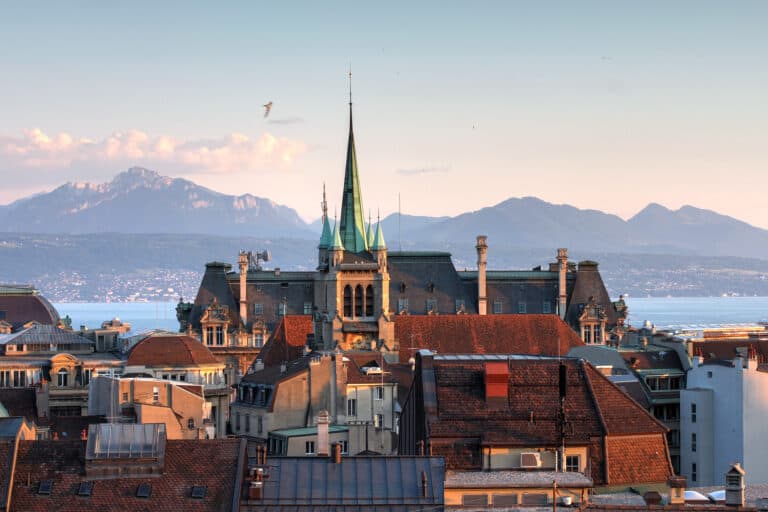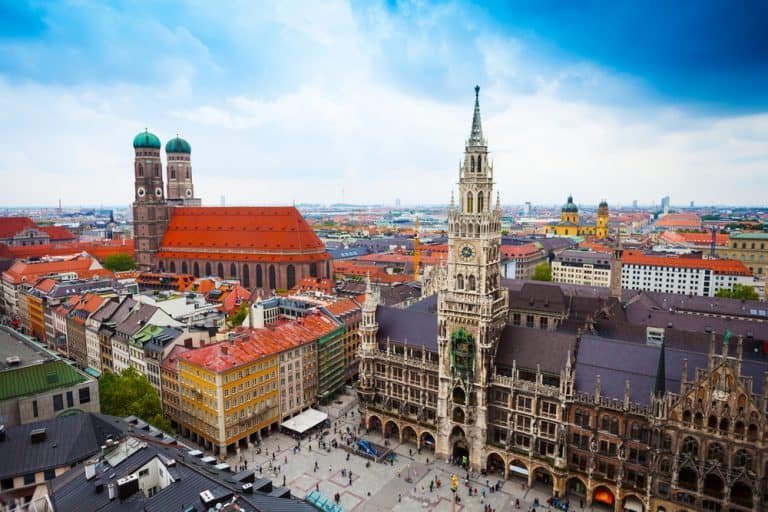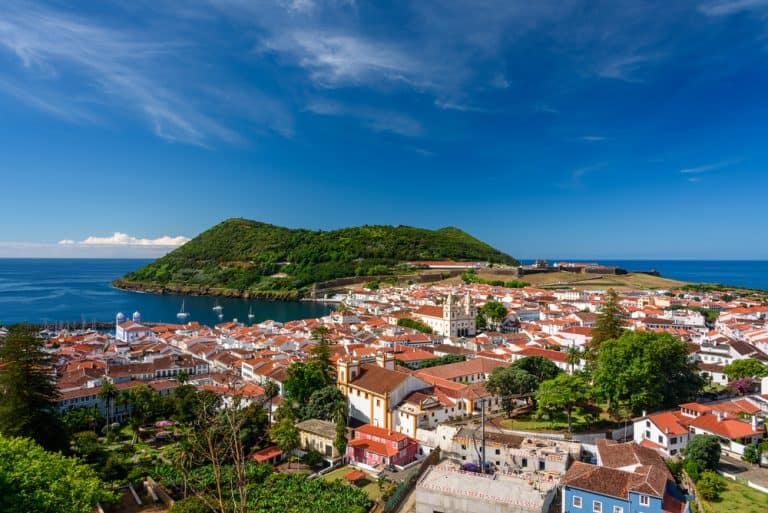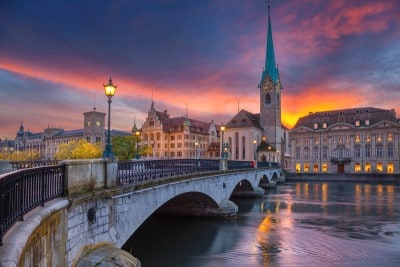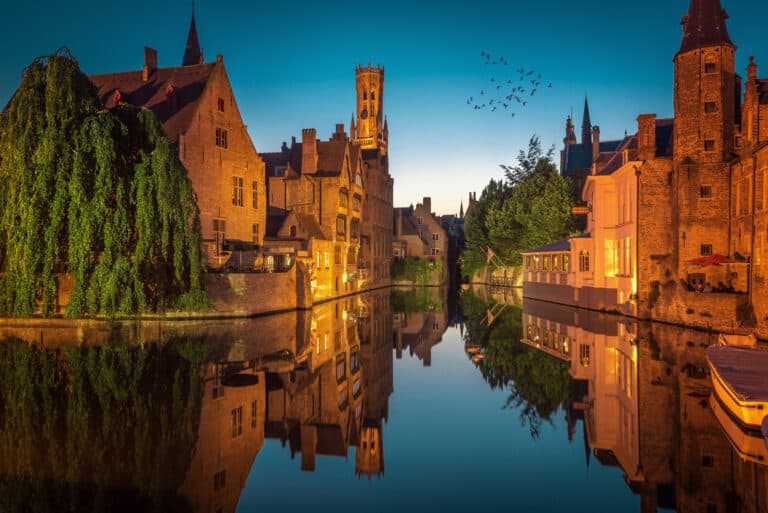A visit to the Charlie Chaplin Museum, Switzerland

The Charlie Chaplin Museum, near Vevey in Switzerland, is a must-see attraction for film buffs, particularly fans of the silent screen and the famous film legend.
This fascinating museum showcases the lifelong work of the famous British-born comic actor, director, filmmaker, and composer who found fame in the United States in the first half of the 20th century and who is best known for his trademark bowler hat, walking cane, and toothbrush moustache.
And it’s just a few minutes outside of Montreux on Lake Geneva – one of the top day trips from Geneva – so is a perfect place to visit if you’re on a trip here. You can also easily get here directly from central Geneva.
We recently visited the Charlie Chaplin Museum Switzerland and genuinely loved it. There’s a lot to learn here in a museum that sits in a perfect location with views out to the mountains beyond.
If you’re a Charlie Chaplin fan, a film buff, or want to visit a fascinating museum in a gorgeous setting, you’ll love it here!
This post contains affiliate links
Where is the Charlie Chaplin Museum Switzerland?
The museum – Chaplin’s World – is situated on the former country estate of the Chaplin family in Corsier-sur-Vevey. This tiny village overlooks the town of Vevey and Lake Geneva (Lac Leman). It is a short journey from Montreux in Switzerland.
The museum is in a beautiful four-hectare park. It comprises two parts: a modern building (the ‘Studio’) that covers Chaplin’s formative years as an actor in London, as well as his rise to fame in Hollywood before moving to Switzerland.
The second part is in the large neoclassical mansion (the Manor House or Manoir de Ban), the Chaplin family’s former home. Here, you can learn about his life in Switzerland from 1952 until his death in 1977.
The Manor House sits in acres of gardens with a vast green lawn. Standing outside the back, you are rewarded with incredible views of the snow-capped mountains in the distance.
You can book tickets to the museum here.

What can you see at the Charlie Chaplin Museum Switzerland?
The Charlie Chaplin Museum neatly divides Chaplin’s life into two distinct periods: his professional life and his personal life.
The exhibits in the modern museum (the ‘Studio’) building, next to the entrance and the souvenir shop, cover Charles Spencer Chaplin’s early acting career in London and his studio work in Hollywood.
You then move to the Manor House to learn more about his personal life and Charlie Chaplin, the family man. Here you really get a better understanding of a man who started his career in silent films and rose to become a legend of the film screen.
Throughout the tour of the Studio and the Manor House, you’ll come across a mind-boggling collection of memorabilia and personal belongings. These span Chaplin’s life from 1889 to 1977.
This includes his trademark bowler hat, vintage movie posters, and props from Chaplin’s films, including the ‘Barber’s Chair’.

There is also a wealth of film footage played throughout the museum. These cover some of his films, critical events in his life, and snapshots of his time in Switzerland and his family life.

Much of this throws a light on how inventive, influential, and in many ways, ahead of his time Charlie Chaplin was. There are also lots of interactive exhibits in the Studio and plenty to keep children entertained.
Start in the Studio
After getting your tickets from the ticket office or scanning your pre-booked tickets, you head to the Studio entrance to begin your tour.
As is fitting for a man who was a giant in the movie industry, this starts in a small cinema. Here, you watch a short 10-minute film that covers the highlights of his long, and at times controversial, career.

The screen then rises, and you walk into a street scene in south London depicting life in the late 19th century.

Chaplin’s early life
This early snapshot of Chaplin’s formative years in poverty gives you a real insight into him. It was also arguably the influence for his most famous character, the Little Tramp (the person with the bowler hat and walking cane).

There are lots of information panels here that you should spend a bit of time reading.
When you do this, you realise that Chaplin’s experiences shaped his future work. For example, his alcoholic father abandoned the family early on. His mother Hannah, who taught him how to observe people who he would then imitate, was committed to an asylum. He apparently worshipped her.
This traumatic experience apparently later influenced a scene in his movie ‘The Kid’ when a character is placed in an orphanage.
You also discover that when Chaplin moved to Los Angeles, he constructed a T-junction at the back of a Hollywood studio to shoot the film ‘Easy Street’. This was a recreation of his life in south London.
Chaplin’s work in Hollywood
It’s impossible to cover everything in this truly fascinating museum. However, the Studio section – which recreates part of a Hollywood-style studio – is great for seeing and learning about different aspects of his craft and the work of Charlie Chaplin.

This includes the need to throw sheets over sets to change the lighting, how he worked with film cuttings and reels, and some of the scripts he wrote.
You can also discover the inspiration behind classic movies like ‘Modern Times’, ‘A Dog’s Life’, ‘City Lights’ ‘The Kid’, and ‘The Gold Rush’. Chaplin is said to be one of the first filmmakers to use a storyboard.
There’s also information here on some of his personal views and how they shaped some of his work.
I already knew Chaplin was socially conscious and despised fascism. But I was surprised to learn that Hollywood didn’t want him to make ‘The Great Dictator’, whose main character was designed to mock fascist dictators such as Hitler.
So when he started shooting the movie less than a week after Britain and France declared war on Nazi Germany, he took a huge financial and personal risk by pursuing the project through to completion.
There is, however, further information in the museum that says he later commented that if he had known the extent of the Nazi atrocities at the time, he would never have made the film and created the character.
Wax figures of famous people
As you wander through the Charlie Chaplin Museum, you’ll come across lots of life-size wax figures of famous people. Some depict Chaplin himself in various different scenes.
Others are actors who shared the stage with him, and famous people that he knew throughout the years of his life. They include Laurel and Hardy, the movie star Sophia Loren, and Albert Einstein.
There is also one of Michael Jackson.

The fact that Michael Jackson was a huge fan of Chaplin’s work and even recorded one of his songs was another surprising fact. The panel by Jackson’s wax figure says that Chaplin’s dance during the ‘Nonsense’ song in the movie ‘Modern Times’ allegedly inspired Jackson’s Moonwalk.
The gardens
When you leave the Studio part of the museum, you walk up a staircase framed with vintage posters promoting famous Chaplin movies. You emerge outside, and at this point in the tour, it is worth taking a welcome break and wandering around the grounds of the park.


It’s a leisurely walk of around 15-20 minutes, which is relaxing and informative. You can take some great photos of the house in one direction and the mountains in another.
One of the information panels notes that Chaplin felt a real affinity with the park and particularly loved the deer to whom he would offer food to. And apparently, when there was heavy snow, he asked the children not to walk on the rolling lawn that runs down from the house towards the lake so that the white covering would remain undisturbed.
The Manor House
It would be easy to miss the tour of the Manor House, as it looks like the building is out of bounds to visitors. But do make sure you look inside, as this is where you get a peek into Charlie Chaplin’s private life.
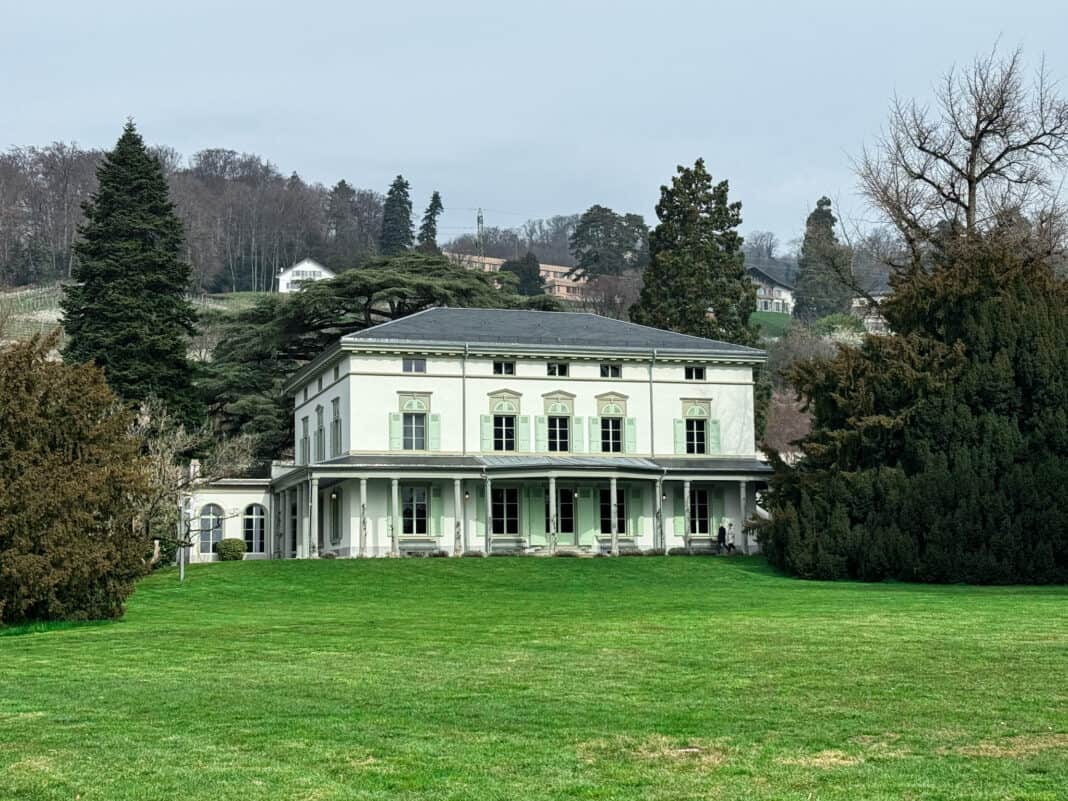
In the entrance, there is a wax figure of Chaplin with his wife Oona pictured behind him.
You can then explore two floors of the family’s former home. This section of the museum features original furnishings and is full of personal mementos.

I found this part really touching, and it brought a lump to my throat at several points. Family photographs are strewn everywhere and more film footage, this time of Chaplin playing with his children or eating on the outside terrace with family and friends.
The ground floor
The ground floor contains several rooms. These are worth spending some time in to better understand what Charlie Chaplin was like as a person.
The living room has fabulous views out onto the lawn and the mountains. In this room, there is information on the importance of music to Chaplin and that both his parents were music-hall singers.
You are told how he collaborated with others when composing music for his films, befriending composers such as Igor Stravinsky and Irvin Berlin. There’s also his violin on display, bought when he was 16.
There are also lots of other facts you learn about in the rooms on the ground floor including the dining room and study. This includes that although the children largely spoke French, he insisted everyone spoke English at the dining table.
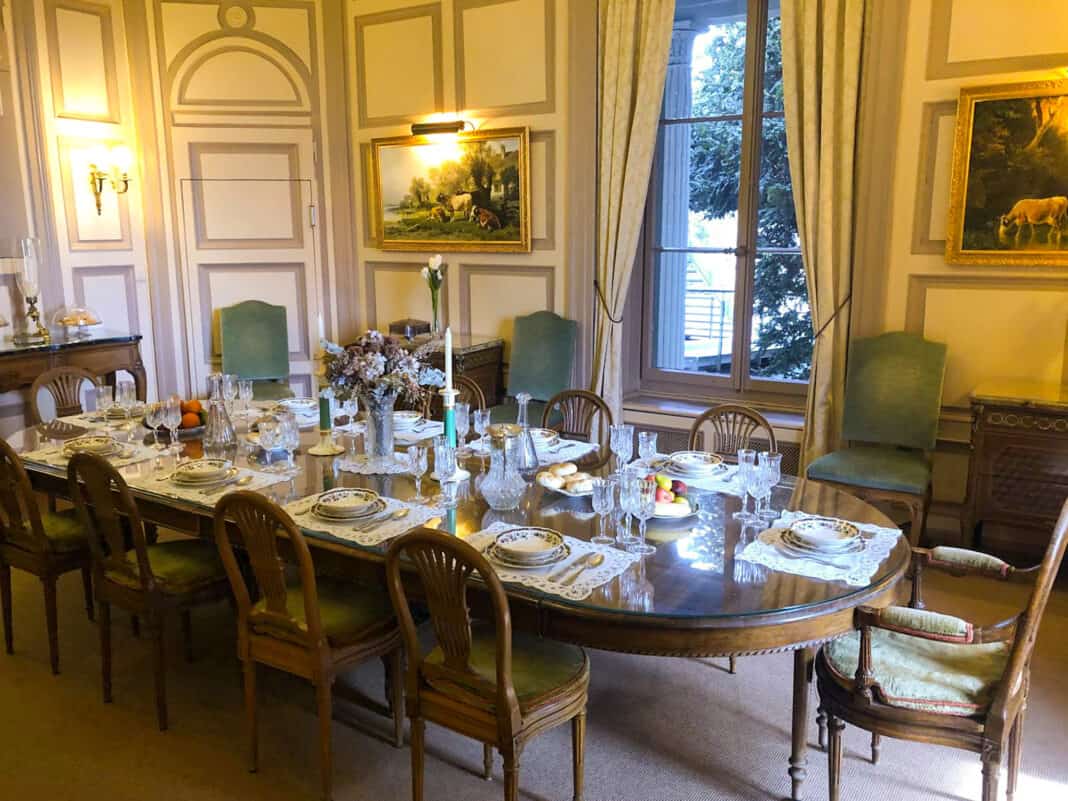
The information on display then covers how Chaplin came to live out his final years in Switzerland.
After his re-entry permit was revoked in late 1952, he was prevented from returning to the United States. Even though he’d lived there for almost four decades, he had sometimes been quite critical of his adopted country.
And when they launched a witch hunt of people in the entertainment business suspected of being communists after World War 2, Chaplin denied being a sympathiser. His outspokenness on social issues may therefore have contributed to the US authorities preventing his return.
The tour continues up a spiral staircase. This takes you past rows of Chaplin caricatures.
There’s then a bathroom with a wax figure of Albert Einstein, a good friend of Chaplin. There’s also a reading room, bathroom and bedroom, along with the ‘Angel Wings’ that were made for the unfinished screenplay of ‘The Freak’.

In the final room, you’ll see wax figures of an elderly Chaplin and his family sitting and watching homemade movies brought to life by a projector. You can still see Chaplin’s comic side as he makes funny faces with his kids and pranks around. It was touching to see this personal side of him.
Further information for your visit to the Charlie Chaplin Museum Switzerland
How to get to the Charlie Chaplin Museum
If you plan to visit the Charlie Chaplin Museum as part of a day trip from Geneva, you can catch the train from Geneva Cornavin (the city’s main railway station) to Vevey train station. The journey takes about an hour.
If you’re visiting from Lausanne, another lovely place on Lake Geneva, it’s only around 15 minutes by train. From Montreux, you can catch the train (a travel time of just four minutes) and then make your way by bus. Or you can catch the 201 bus from Montreux and then switch.
When you arrive at Vevey station, exit the station and walk across the main road to the bus stop. Usually, you’d take the 212 bus to the ‘Chaplin’ stop, which is right outside the entrance to Chaplin’s World.
However, when we went, the 212 bus wasn’t running, so we got the 201 bus to the Vevey Funicular stop (the 212, 213, 216 and 217 lines also run to this stop). Here, we picked up a free transfer to the museum’s entrance.
If you are travelling while the 212 bus service is disrupted, it’s worth getting to the museum early. The transit driver takes a lunch break, and so there are no pick-ups and drop-offs at Vevey Funicular for a couple of hours over the lunchtime period.
Hopefully the disruption – which is apparently due to a landslide in the area – is only temporary, so check out the website before you go.
Opening hours and entrance tickets
The Charlie Chaplin Museum is open from 10 am until 5 pm.
Other facilities
There is a café onsite that serves light refreshments and has toilets.
There is also a shop if you want to pick up souvenirs of your trip.
A visit to the Charlie Chaplin Museum Switzerland
I hope you enjoy the Charlie Chaplin Museum as much as we did.
If you’re in the area and haven’t seen it, you should also check out my guide to one day in Geneva. You can download a free itinerary for your trip there.
Other great places to visit not far from Geneva include Lausanne, Montreux and Vevey itself. Neuchatel is also not far away.
Other places to visit as part of your Switzerland travels include Bern and Zurich.
Schaffhausen and the Rhine Falls (Europe’s largest waterfall) are also great day trips from Zurich.
Written by Nick Warburton with Emma Marshall



